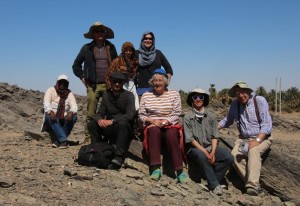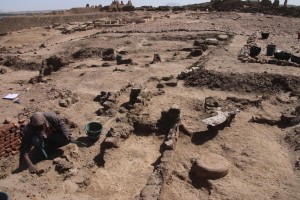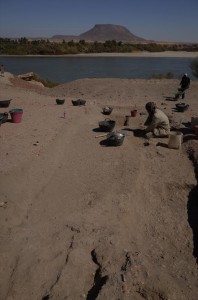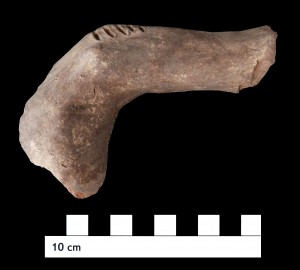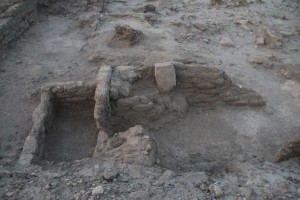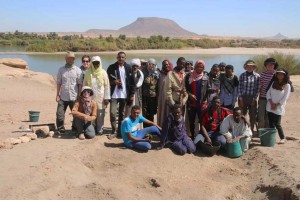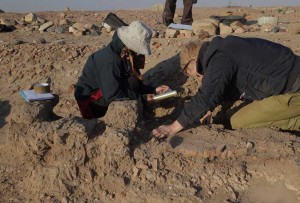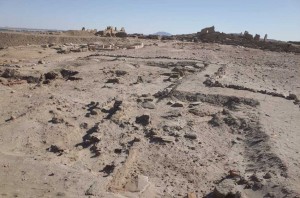In a season with many excellent finds, this beautifully crafted six-sided dice (SAV1E 2771) stands out as one of the best. The dice is well preserved and missing only a small piece of the corner between faces three and four. In addition to the standard dots (pips), each number received further decoration: a circle around the one, incised lines connecting the dots of two through five, and a fern pattern filling the face of six. Though the popular game of senet used stick die as early as the Predynastic Period, the six-sided dice did not reach Egypt until much later than our New Kingdom focus. Nonetheless, the detailed and artistic production of this example from SAV1 East makes it a highlight of the 2016 season.
Category Archives: Upper Nubia
Gold working and quarrying in Nubia – some new perspectives
One of the aims of this season was a detailed check of the quarries on Sai Island, especially research on the nice „white sandstone from Shaat“, as the Egyptians called the building materials in inscriptions in Kumma and Semna. Another perspective connecting to raw materials was the question of ancient goldworking in the region of Sai.
For both questions, two distinguished colleagues from Munich joined us as external expert: Dietrich and Rosemarie Klemm are well known in Egyptology and Sudanarchaeology as specialist for gold and quarries in Egypt and Nubia. Their recent publication (Gold and gold mining in Ancient Egypt and Nubia. Geoarchaeology of the ancient gold mining sites in the Egyptian and Sudanese Eastern deserts. Heidelberg; New York; Dordrecht; London 2013) – is extremely useful for all of us working in Upper Nubia where the “gold of Kush” was of such a high importance.
I am very grateful that they agreed to join AcrossBorders for 1 week in the field – their rich input for the project and the tremendous knowledge we were lucky to experience and share during these days cannot be put in words! Our understanding of the sandstone quarries on Sai is now much advanced.
We also managed to organize an excursion to Gorgod, a site north of Sesebi. There are a number of simple stone huts – together with grindstone fragments and modern gold mining activities, these might indeed be seen in connection with gold exploitation of Post-New Kingdom date. On the way to Gorgod, we passed several modern gold mining camps – again a very useful experience to all of us.
Dietrich and Rosemarie Klemm have left Sai Island today – on behalf of my team I would like to express my sincere gratitude – their contribution and stay with us will be held in highest regards!
Official start of the cemetery season 2016
Today was the official start to work in cemetery SAC5, focusing on tomb 26 and its neighborhood. Unfortunately we had to return to tomb 26 already on January 1, at the beginning of the town season, because looting was reported. Thank god, the damage was not as bad and we were able to stick to our original schedule for the cemetery season after 3 days of cleaning. Today, we started removing the debris in the burial chamber – clear evidence was found for ancient looting and the hopes for finding major remains of the original burials are now quite low!
Nevertheless, we are looking much forward to focus now for the next 4 weeks on the burial ground of the people working and living in the New Kingdom town. In any case the information will be valuable and contribute to a better understanding of living conditions on Sai Island in the 2nd millennium BCE.
End of Sai Island New Kingdom town season 2016
Time flies by – the town season 2016 was officially closed yesterday and celebrated together with all workmen with a traditional sheep-dinner and party last night!
Week 6 on Sai Island focused on “cosmetic work” at SAV1 East – the complete area was cleaned for the final surface documentation, description of features and drawings.
Specific areas and small features were excavated – most importantly a very interesting part of Square 4C with a newly discovered rectangular storage pit (feature 76) and impressions of two firing places for baking plates within the pavement associated with this feature. This is one of the rare cases were intact, undisturbed contexts from Dynasty 18 were documented at SAV1 East.
The final task at SAV1 East was to fully excavate feature 15. Wall 44, set into the cellar/feature 15, was carefully dismantled step by step, brick by brick. Although I proposed a dating for the building phases of cellar and wall already last year, firm proof was still missing as the deposit below wall 44 was not yet accessible.

Wall 44, set into feature 15, was carefully removed in order to document the western part of feature 15 and the deposit below the wall.
Having now cleaned the entire feature, my preliminary assessment was strengthened: both the pottery and seal impressions from below wall 44 testify to a dating in the reign of Thutmose III. Thus, wall 44 was built into feature 44 not prior to the mid/late reign of this king – corresponding nicely to the proposed main building phases of Building A.

Sieving the undisturbed contexts in feature 15 was again very successful: a number of artefacts, most importantly seal impressions were found!
Excavations in test trench 1 in the new area SAV1 Northeast continued in week 6 as well – and the results are very promising: a substantial mud brick structure of mid-18th Dynasty date was discovered! Very likely the eastern enclosure wall of Sai city, enabling us to upgrade the town map!
A more concise summary of the town season will follow – for now I would like to thank the team members who have already left the island (Jördis Vieth, Klara Sauter and Adrian de Vries): the data collected in the last weeks are extremely rich and will keep us very busy for a while!
Hidden Highlights 1: SAV1W 1677
In the course of every season at Sai we find a lot of great material culture that never appears in the blogs, either in the form of the weekly highlights or themed object posts. Some of these things are rare and beautiful. Some of them are weird and wonderful. So, we thought we would start a series of posts to showcase some of our favorite finds of the season. Hopefully you love them as much as we do!
Here at Sai we are no strangers to figurines. In fact, there are nearly one hundred entries in the database classified as figurines, most often zoomorphic. Of this large collection, none are quite like SAV1W 1677…
SAV1W 1677 is the head portion of a larger animal figurine. The eyes are represented by small points of clay pulled out from the head. Between the eyes are nine incised lines, which look very much like the mane of a horse. The elongated mouth and nose of the figurine are also rather equine. Horse figurines are well known within our corpus, with many already featured here on the blog.
 However, it is clear that these features have been grossly exaggerated for this figurine—the snout itself is 60mm in length! Furthermore, rather than the rounded muzzle of a horse, here the snout flares out and the end surface is concave. No incised details for either the nostrils or mouth have been added. Unfortunately the surface is slightly burnt, so it is not possible to tell if additional details were also added in paint.
However, it is clear that these features have been grossly exaggerated for this figurine—the snout itself is 60mm in length! Furthermore, rather than the rounded muzzle of a horse, here the snout flares out and the end surface is concave. No incised details for either the nostrils or mouth have been added. Unfortunately the surface is slightly burnt, so it is not possible to tell if additional details were also added in paint.
Thus, it may be that this creature only shares equine features and is not intended to portray a realistic horse. Perhaps it is simply a creation living only in the mind of the artisan. And being on an island, isn’t it possible that their fictional creatures are river dwellers? Could this in fact be evidence of a local Nile monster? The Nubian Nessy!?
Summary of week 5 at Sai Island, Pharaonic town
As planned, excavations at SAV1 West have come to an end after 5 weeks. At SAV1 East, there are still small things to do – first of all, the final cleaning in feature 15, the large cellar which yielded numerous clay sealings and complete pottery vessels in 2015. The westernmost part of the structure was left unexcavated last year.
At SAV1 West, work focused during this week on feature 123, a very interesting, but still obscure structure with several building phases. In the surroundings of feature 123, remains of occupation deposits and some pavements were documented.
We also returned to Square 1NW – located in the norther western part of SAV1 West, first opened in 2014 and covering an area in front of the enclosure wall, outside of the Pharaonic town. Interesting remains of mud brick structures and floor levels were observed and will be documented in the upcoming week – hopefully we will be able to add information to the layout of the western façade of the 18th Dynasty enclosure wall – and the later reuse of this area outside of the town.
With the arrival of Sean Taylor and Sayantani Neogi, some micromorphologial samples were taken in SAV1 West and SAV1 East. Complementing our digital landscape model based on kite photography by Martin Fera, Sean and Sayantani also started augering in the western part of the site in order to understand the ancient topography within the context of the New Kingdom town.
Work at SAV1 East focused on the extension towards the northwest – Square 4B1 yielded not only in situ schist fragments and fragmentary walls, but also a very nice sandstone column.

Overview of Square 4B1 in SAV1 East with a sandstone column close to the in situ-remains of the schist pavement. Note the differences in levels!
Some areas at SAV1 East with 18th Dynasty deposits in Squares 4B and 4C like the one below the in situ baking plate will be excavated in the upcoming week (the deposit has already been sampled for micromorphology).
Finally, we opened a new test trench in the northern part of the town area, just above the sandstone cliff (labelled SAV1 Northeast) – the aim is to check whether an eastern enclosure wall is traceable in this area or not. We are still just below the surface, but some remains of bricks and a promising sandy area were already revealed. Interestingly, Ramesside sherds were present among the ceramics.
Of course, work on the pottery and objects continued simultaneously with the excavation. From SAV1 West, 430 baskets of pottery were processed in 2016! But this is beaten by SAV1 East which yielded a total of 610 baskets… in retrospect, really amazingly large numbers of ceramics! Thanks to these amounts, the phasing and corpus from both sectors are now well established.
Our registrar Meg Gundlach was very busy with a considerable number of finds in the last week – one of the highlights from the town excavation in 2016 is definitely the scarab SAV1 East 1595. I was lucky to find it myself while cleaning the floor in one of the rooms attached to feature 51 in SAV1 East. The scarab beetle itself, made from steatite (12 x 16 mm), has been hacked off, leaving just the decoration on the back. A crudely carved winged cobra/vulture holds a shen-ring with her talons, protecting an empty cartouche in front of her.
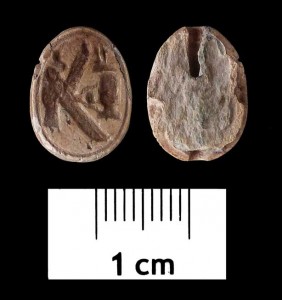 Week 6 will allow documenting and describing the excavated features in more detail; and we will also start our landscape survey in the area to the south of Gebel Abri. Very excited about the upcoming tasks and happy with the results so far!
Week 6 will allow documenting and describing the excavated features in more detail; and we will also start our landscape survey in the area to the south of Gebel Abri. Very excited about the upcoming tasks and happy with the results so far!
End of week 5 at SAV1 West and SAV1 East
Today, fieldwork officially ended in the New Kingdom town of Sai – five very successful weeks came to an end at both SAV1 East and SAV1 West. Other than last year, timing was excellent (no unexpected cellars…): at SAV1 West everything was achieved and at SAV1 East small scale excavation is waiting – exactly as planned – for me and just a small group of workmen next week.
This is therefore the perfect opportunity to thank all of our Sudanese workmen: Like in the last years, the gang, this time directed by Hassan Dawd, did a marvelous job – despite weeks of really cold weather, days of nimiti-fly attacks and stormy periods, they always did their best; all of our excavations results (a summary of the most important finds will soon follow!) depend on their hard work and expertise they gained over the last years. And, of course, the help and friendship of our colleague Huda Magzoub from NCAM are essential for a successful season and much appreciated.
Many many thanks to all team members, Sudanese and international, and looking much forward to the second half of AcrossBorders’ fieldwork – 5 weeks of documentation in the field, small scale excavation, landscape survey and work in the cemetery SAC5!
Tracing cooking and baking activities at SAV1 East
Among other aspects of daily life activities, AcrossBorders aims at studying in detail the craft specialisation of functional ceramics associated with cooking and baking and various aspects of food preparation. Here, the co-existence of Egyptian style (wheel-made) and Nubian (hand-made) cooking pots as well as the import of real Egyptian cooking pots are of particular interest. Today, a large fragment of a cooking pot produced in Egypt was documented at SAV1East in Square 4B – obviously in situ, set into an ashy deposit next to a wall and still filled with some ashy material and charcoal.
Another really interesting in situ situation with a functional ceramic type was found in Square 4C: a large baking plate is still in place – close to a mud brick wall, sitting on a very ashy deposit.

Luckily a good portion of this 18th Dynasty baking plate was left in place despite the pitting of the area in Medieval/Ottoman times.
Until now, we only had small fragments of these plates from SAV1 East and otherwise hundreds of conical bread moulds (probably associated with the nearby Temple A). The new baking plate and its find context are therefore of particular interest – therefore we decided to take a micromorphological sample from the ashy deposit associated with this area (and nicely “sealed” by the baking plate on top) which might have functioned as temporary “kitchen”.
These new data from SAV1 East – ceramics, archaeological context and micromorphology – will contribute to a better understanding of some aspect of food preparation within the New Kingdom town of Sai.
Exposing in situ-remains of Dynasty 18
Week 4 of fieldwork in SAV1 West and SAV1 East was very busy and fruitful – in both areas we have by now exposed in situ-remains dating from Dynasty 18, the main occupation phase of the New Kingdom site.
At SAV1 West, work in Square 1S, partly excavated in 2015, was continued – and feature 123 along the southern baulk of the trench is getting more and more exciting. We have not yet cleaned its foundation level, but have reached clear occupational deposits of high interest.
Work was also continued in the “wall street” – exposing more layers which will hopefully be of excitement for our micromorphologists arriving next week!
At SAV1 East, a very nice area for bread making (on a flat baking plate) was discovered – the baking plate was cut and partly hacked away like all the surrounding structures and layers. BUT: below the plate there are still 20 cm of occupational deposit – very exciting and again a task for Sean Taylor and Sayantani Neogi!
With two walls in Square 4B going into the northern baulk, we were forced to extent our excavation area: Square 4B1 covers 3 extra meters to the north and to the west.
And here we really found the extension of the walls. Most importantly, my assumption that we had remains of a collapsed schist pavement in the northwestern corner of Square 4B was proven to be correct: yesterday just before noon, I cleaned the scarce but definitely solid and in situ remains of a very nice schist pavement! It was not easy to find, as it is was literally covered by mud brick debris and is cut off from all four sides!
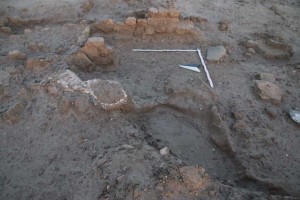
View on scarce remains of what used to be a schist pavement – cut off on all edges in medieval time.
All in all, with this last puzzle piece, it is now completely clear that our large rooms/magazine areas equipped with the sophisticated schist pavement extended to the west – of much importance for understanding the town plan of Sai.
In terms of pottery, I already shared some excitement about very nice findings from SAV1 West. At SAV1 East, it is less spectacular, but very interesting: still, mostly bread and beer! And all pottery associated so far with the walls and pavements are clearly mid-18th Dynasty in date, most probably Thutmose III. Our 2016 results therefore nicely back up the work of years 2013-2015.
Since Ken Griffin is back to teaching at Swansea, Meg Gundlach is carrying on with the registration of finds on her own at the moment – assisted by Huda Magzoub for some Munselling, and more assistants will arrive in mid-February. There were a number of really exciting finds this week – animal figurines, female figurines and most importantly the first seal impression of this season from SAV1 East!
After 4 four weeks of excavation, I am very happy with the progress so far and looking much forward to the results of the upcoming week…
A modified Egyptian cooking pot from SAV1 West?
Work is progressing well in SAV1 West – occupational deposits and new sections of walls with several phases of use datable to the mid and late 18th Dynasty have been exposed in the last days. The ceramics are very exciting – a large percentage of Egyptian marl clay wares, considerable amounts of painted wares and a very good state of preservation.
One context was especially interesting and I would like to share first impressions, hoping for some feedback at this early stage of processing. The stratigraphic unit in question comprises the last level of debris covering a small mudbrick structure in the south-eastern corner of Square 1SE. Because of its preservation, it is very likely that the pottery represents the original inventory that was shifted/mixed when the late antique pitting in the area occurred, cutting down to the original layers.
154 diagnostic sherds attest to a late 18th Dynasty date. 12 % of these diagnostics were Nubian cooking pots with clear traces of use (their surface is smoked and soothed) – mostly with basketry impression and one single piece with incised decoration. Except that this is quite a high amount of Nubian pottery, all is consistent with the findings in SAV1 West so far. Most of the Nubian cooking ware in the New Kingdom town of Sai features basketry patterns, whereas coarse incised patterns with diagonally cut lines below the rim (very common at Elephantine and mostly associated with the Pangrave culture) is less common.

Snapshot from the field: the pencil marks the unique sherd in question; below are some of the Nubian sherds.
What makes the context in Square 1SE special is one rim sherd: An Egyptian Nile clay cooking pot occurs side by side with the Nubian ones – basically, something which is not unusual, but already well attested at SAV1 West. Imported, authentic Egyptian wheel-made cooking pots and locally made examples thrown on the wheel are used side by side with Nubian-style products in New Kingdom Sai and were found in all sectors in the Pharaonic town (SAV1 North, SAV1 East and SAV1 West).
But: this authentic Egyptian cooking pot (produced in and imported from Egypt) is not smoked (so maybe was not yet used?), but displays a very unusual feature. Below its rim, there are several diagonally arranged black lines – definitely painted/drawn. With these strokes, the Egyptian cooking pot resembles Nubian style variants with incised decoration. So-called hybrid styles – Nubian surface treatments on otherwise Egyptian pottery vessels – are well attested at Sai, other Nubian sites and also Elephantine. But is this also the case with the unique piece in question? Did the “artist” of these black lines wanted to show that something is missing on this pot? Was it a spontaneous idea of someone familiar with the incised cooking ware? Or are these lines really to be interpreted as decoration, to fuse Nubian cooking tradition with the Egyptian style? Since the authentic Egyptian cooking pots are made and fired in Egypt, it was of course not possible to apply pre-firing incised decoration on them like on the Nubian ones and the hybrid forms at Elephantine. On the other hand, we have a number of locally produced Egyptian style cooking pots on Sai – and none of them shows incised decoration…
Much food for thought and a lot of open questions – but at the end of a long working day with much routine work and processing, findings like these are inspiring and give fresh ideas and much energy!


